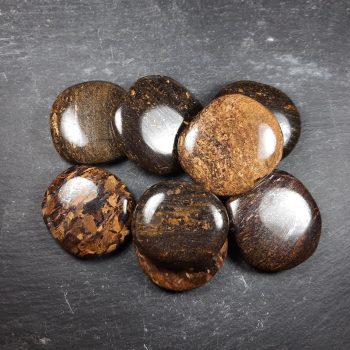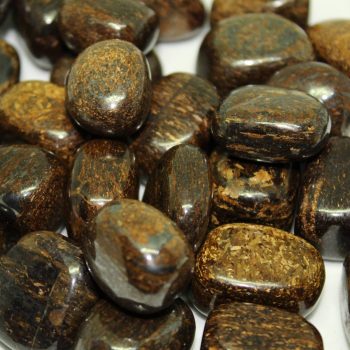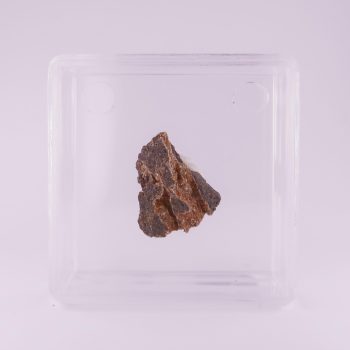Enstatite
Enstatite is a member of the pyroxene group of minerals, typically occurring in prismatic or elongated crystals. The best known member of the group is probably Bronzite.
Showing all 4 results
-

Bronzite Palmstones
Price range: £4.00 through £5.00 -

Bronzite Tumblestones
Price range: £1.00 through £3.00 -
New

Enstatite and Pseudobrookite from Nickenicher Sattel, Germany
£2.50 -
Updated

Enstatite, Pseudobrookite, Rhonite from Nickenicher Sattel, Germany
Price range: £2.50 through £3.00
Information about Enstatite
Enstatite is a member of the pyroxene group of minerals, typically occurring in prismatic or elongated crystals. It is often found in shades of brown, greenish-brown, gray, or even bronze-like hues, with a vitreous to submetallic or pearly luster.
It can also display a schiller effect, a metallic-like sheen caused by light reflection from its internal structures. Enstatite is usually translucent to opaque, though some high-quality specimens can be transparent and are valued as gemstones.
Enstatite forms a series with Ferrosillite – Mg2Si2O6 to Fe2Si2O6
An intermediary member of this series was once known as Hypersthene ((Mg,Fe)2Si2O6), but this was discredited by the IMA and should be labelled as an Enstatite group member.
Another well known member of the group is Bronzite – (Mg,Fe2+)2[SiO3]2.
Uses and History
Enstatite is primarily of geological and scientific interest, helping researchers understand the formation of igneous and metamorphic rocks, as well as meteorites.
Gem-quality enstatite is rare but can be cut into faceted stones or cabochons for collectors and high-end jewelry. Additionally, enstatite’s presence in meteorites provides insight into planetary processes and early solar system history.
Enstatite was first identified in the 19th century, with its name derived from the Greek word “enstates,” meaning “resistor,” due to its high melting point. It has since been recognized as a common mineral in mafic and ultramafic rocks, as well as in meteorites.
Enstatite has been studied extensively for its role in mantle processes and its significance in planetary geology.
Mineralogy
Typically an olive green – olive brown colour, but can be brown, yellow green, green-white, grey, white.
Hazards and Warnings
Mineral collectors should wash their hands after handling specimens, to avoid any exposure to potential toxins.
Almost all rocks, minerals (and, frankly, almost all other substances on earth) can produce toxic dust when cutting, which can cause serious respiratory conditions including silicosis.
When cutting or polishing rocks, minerals, shells, etc, all work should be done wet to minimise the dust, and a suitable respirator or extraction system should be used.
Translations
Arabic:
Hindi:
Portuguese:
Bengali:
Indonesian:
Punjabi:
English:
- enstatite
Italian:
Russian:
- Энстатит
French:
Japanese:
- エンスタタイト
Spanish:
- Enstadita
- Enstatita
German:
- Enstadit
- Enstatit
Korean:
- 엔스타타이트
Thai:
Gujurati:
Mandarin Chinese:
- 顽火辉石
Urdu:
